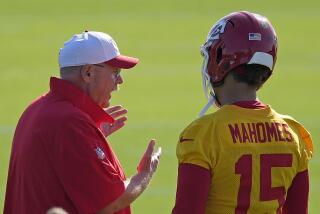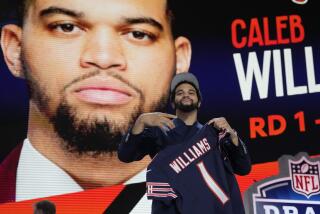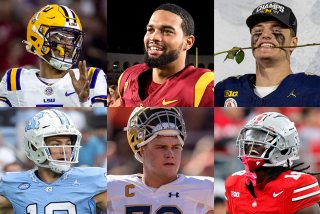It may be time to pass torch to NFL’s rookie QB Class of 2012
Twenty-nine years ago, representatives from each NFL team — there were 28 at the time — gathered for the draft in the ballroom of a Sheraton hotel in New York City.
No hoopla. No fans with painted faces. Hardly any media.
“It was nothing, a gathering of people,” recalled Dave Goldberg, who covered the NFL for the Associated Press for 26 years. “There were all sorts of hangers-on from local television who would show up at dinner time for the free food. Other than that, nothing.”
Who could have known that history would be made? That turned out to be the gold standard of quarterback drafts. Six were taken in the first round, four would reach the Pro Bowl, four would play in Super Bowls, and three — John Elway, Jim Kelly and Dan Marino — would make it all the way to the Pro Football Hall of Fame.
The others taken in the first round were Todd Blackledge by Kansas City, Tony Eason by New England and Ken O’Brien by the New York Jets, with Eason and O’Brien having the more productive careers of those three.
In the three decades since, every quarterback draft class of note has been held up to that one, and almost every one has paled in comparison. Although there was much fanfare surrounding the ultimately disappointing 1999 class (Cleveland’s Tim Couch, Philadelphia’s Donovan McNabb, Cincinnati’s Akili Smith, Minnesota’s Daunte Culpepper, Chicago’s Cade McNown), the group from 2004 has had the most success since 1983 — Eli Manning of the New York Giants and Pittsburgh’s Ben Roethlisberger each have two Super Bowl rings, and that draft also included San Diego’s Philip Rivers and Atlanta’s Matt Schaub (now in Houston).
But this year’s class of rookies, which has already found its way into the record books, has 1983-type potential. Though no one could know if any of these quarterbacks are Canton-bound, or if they will play in Super Bowls, these first-year quarterbacks have further changed how teams look at the position.
A record five rookie quarterbacks were Week 1 starters this season: Indianapolis’ Andrew Luck, Washington’s Robert Griffin III, Miami’s Ryan Tannehill, Seattle’s Russell Wilson and Cleveland’s Brandon Weeden. Rookie Nick Foles has taken over for the injured Michael Vick in Philadelphia, and Sunday, after Griffin suffered a knee injury against Baltimore, fellow rookie Kirk Cousins led the Redskins to an eight-point comeback in the final minute and eventually to an overtime victory.
“Usually with rookies, if they’re still upright, you’re like, ‘Wow, great year!’” said Hall of Fame quarterback Steve Young, who was selected in the 1984 supplemental draft and spent his first season with the USFL’s Los Angeles Express.
“But this year you’re talking about people who aren’t just surviving, they’re important. Important people in the big picture for the division, important for the playoffs. These guys are redefining what it is to be a rookie quarterback. No one will ever have the same expectations again.”
Strength in numbers
The most surprising part of this year’s quarterback class is the sheer number of productive ones, not necessarily that rookies are starting from day one. The groundbreakers in that regard were Atlanta’s Matt Ryan and Baltimore’s Joe Flacco, the first two quarterbacks selected in 2008. Both started from opening week, and both quarterbacked playoff teams as rookies. After them, the notion of keeping a rookie quarterback on the bench seemed antiquated.
Still, the success of this year’s class has impressed some of the league’s most exacting quarterback observers. Asked if the class of 2012 might someday be the new 1983, Elway said: “Time will tell and it’s all going to play out, but there’s no question with the years that they’re having right now, it’s going to get them in the discussion. The ability is there.”
The comparisons between Elway and Luck are striking. Both played at Stanford and were chosen No. 1 overall, and both were taken by the Colts, although Elway successfully forced a trade to Denver. Like Elway, Luck is big and mobile, has a strong and accurate arm, and is masterful at walking his team back from the edge of defeat.
Luck directed his sixth fourth-quarter comeback of the season Sunday, guiding the Colts to a 27-23 victory over Tennessee, and has already eclipsed the record for yards passing by a rookie with 3,792, 53 more than Peyton Manning with the Colts had in 1998. If Luck averages 87 yards over the final three games, he will break Cam Newton’s NFL rookie mark of 4,051 set last year.
Few people expected much of the Colts this season, with Manning gone and the team coming off a 2-14 season. So it’s jaw-dropping to consider they are 9-4 and in the thick of the playoff hunt.
“I saw Andrew a ton when he was here at Stanford,” Young said from the Bay Area in a phone call. “I said to myself, ‘This guy’s really uniquely qualified.’ You can’t ever predict for sure, but to take a team that’s flat on its back and do what he’s done? He’s doing the thing that you expect a fifth- or sixth-year guy to do.”
Rookie competition
In another year, Luck would be the runaway winner of the offensive-rookie-of-the-year award. But the performances of Griffin and Wilson have been similarly spectacular.
Griffin, the Heisman Trophy winner from Baylor who was selected second overall, has pumped life back into the Redskins with his forehead-slapping elusiveness and astounding passing accuracy. Washington has won four in a row and is in contention for the NFC East crown, tied with Dallas at 7-6 behind the 8-5 New York Giants.
Redskins Coach Mike Shanahan said Monday that Griffin suffered a Grade 1 sprain of the lateral collateral ligament on the outside of the right knee and is “definitely not ruled out” of Sunday’s game at Cleveland.
Don Shula, the Hall of Fame coach who used the 27th pick to bring Marino to Miami in 1983, said he has been most impressed this season by Griffin, who leads the league with a 104.2 passer rating. He has 18 touchdown passes — and has run for six — with only four interceptions.
“You’ve got to go with RG3,” Shula said. “Because of all of his great athletic ability, and the pressure that he can put on a defense, either with his arm or his legs. That makes him that much more complicated and harder to defend when a quarterback has got those kind of skills.”
Wilson, a third-round pick who earned Seattle’s starting job over coveted free agent Matt Flynn, has assembled a strong case for offensive-rookie-of-the-year honors. Wilson has 20 touchdown passes, most of any rookie, with nine interceptions (half as many as Luck).
The 8-5 Seahawks have won four of five and are still contending for the NFC West title with 9-3-1 San Francisco. Their Dec. 23 game in Seattle has been flexed to prime time.
“Russell Wilson,” Young said. “I didn’t expect him to go in there and deliver knockout blows to teams the way he has.”
Tannehill and Weeden have shown flashes of strong promise, even though their teams are 5-8.
Early seasoning
There are several reasons for the surge of young, successful quarterbacks. In the NFL, defenses are hamstrung by rules that favor the offense — and protect the quarterback — which paves the way for more passing yards and scoring. And, because of the money involved, there’s pressure to get players on the field as soon as possible, although the new salary structure means top rookies make a lot less than they used to on their initial contract.
But the seasoning of these quarterbacks starts much earlier than that.
“They’re preparing kids for the next level a lot sooner,” said Kelly, who led the Bills to four consecutive Super Bowls from 1991-94. “And kids are starting to get a better grasp because of early teaching when they’re young and not having to wait until they get to college to learn how to read defenses. They’re learning to do this in high school now, and even junior high.”
Will the 2012 class truly measure up to that of 1983? We won’t know for years, but clearly the latest group is teeming with potential.
“You’re going to have [a Hall of Fame player] in Andrew Luck, unless he gets hurt,” Young said. “And you get the feeling with Robert, how he just handles it, these are two guys who are going to be at it for a long time.
“And you’ve got to feel like the other three, the fact that they’ve survived their rookie years and are actually in some ways thriving . . . I’ve got a feeling that you might have five guys who are productive for many years.”
twitter.com/LATimesfarmer
More to Read
Go beyond the scoreboard
Get the latest on L.A.'s teams in the daily Sports Report newsletter.
You may occasionally receive promotional content from the Los Angeles Times.











